-
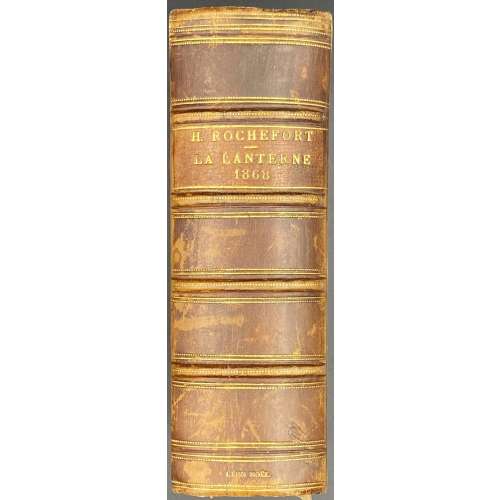 Description: Owner’s quarter calf over marbled boards, 14.5 x 10.5 x 4.5 cm, spine with raised bands, gilt-lettered brown label “H. ROCHEFORT | LA LANTERNE | 1868 | LÉON NOËL”, marbled endpapers; first 11 issues of Henri Rochefort’s journal bound together with original front and back red pictorial wrappers. Front wrapper (first two issues white of red, subsequent issues black on orange background, the text is similar): La | Lanterne | par | {vignette of the lantern} Henri Rochefort | Prix: 40 centes | Bureaux : | 3 rue Rossini & rue Coq Héron, 5 | PARIS || Back wrapper (first two issues white of red, subsequent issues black on orange background, the text is similar): La Lanterne | PARTAIT TOUS LES SAMEDIS | (52 fois par an). | — | Prix d’Abonnement | Un An 20 fr | Six Mois 10 fr | Trois Mois 5 fr | — | Les Mandats doivent être adresses | A Mr. Dumont ADMINISTRATEUR | ❦ | Imprimerie Central des Chemins de Fer A. Chaix & Cie | 20, rue Bergère, à Paris_4608 _ 8 || Collation/pagination: 3 blanks, № 1: fw [1] 2-56 [8] bw; № 2: fw, [57] 58-115 [116] [2] bw; № 3: fw [117] 178 bw; № 4: fw [179] 180-238 [4] bw; № 5: fw [239] 240-298 [4] bw; № 6: fw [299] 300-361 [362] bw; № 7: fw [363] 364-423 [424] [2] bw; № 8: fw [425] 426-483 [484] [4] bw; № 9: fw [1] 2-58 [6] bw; № 10: fw [1] 2-58 [6] bw; № 11: fw [1] 2-59 [60] [4] bw; 3blanks. Contributors: Victor Henri Rochefort, Marquis de Rochefort-Luçay (French, 1831 – 1913) – editor. Alban Chaix (French, 1860 – 1930); Napoléon Chaix (French, 1807 – 1865) – publishers. Dubuisson et Cie (Paris) – printer.
Description: Owner’s quarter calf over marbled boards, 14.5 x 10.5 x 4.5 cm, spine with raised bands, gilt-lettered brown label “H. ROCHEFORT | LA LANTERNE | 1868 | LÉON NOËL”, marbled endpapers; first 11 issues of Henri Rochefort’s journal bound together with original front and back red pictorial wrappers. Front wrapper (first two issues white of red, subsequent issues black on orange background, the text is similar): La | Lanterne | par | {vignette of the lantern} Henri Rochefort | Prix: 40 centes | Bureaux : | 3 rue Rossini & rue Coq Héron, 5 | PARIS || Back wrapper (first two issues white of red, subsequent issues black on orange background, the text is similar): La Lanterne | PARTAIT TOUS LES SAMEDIS | (52 fois par an). | — | Prix d’Abonnement | Un An 20 fr | Six Mois 10 fr | Trois Mois 5 fr | — | Les Mandats doivent être adresses | A Mr. Dumont ADMINISTRATEUR | ❦ | Imprimerie Central des Chemins de Fer A. Chaix & Cie | 20, rue Bergère, à Paris_4608 _ 8 || Collation/pagination: 3 blanks, № 1: fw [1] 2-56 [8] bw; № 2: fw, [57] 58-115 [116] [2] bw; № 3: fw [117] 178 bw; № 4: fw [179] 180-238 [4] bw; № 5: fw [239] 240-298 [4] bw; № 6: fw [299] 300-361 [362] bw; № 7: fw [363] 364-423 [424] [2] bw; № 8: fw [425] 426-483 [484] [4] bw; № 9: fw [1] 2-58 [6] bw; № 10: fw [1] 2-58 [6] bw; № 11: fw [1] 2-59 [60] [4] bw; 3blanks. Contributors: Victor Henri Rochefort, Marquis de Rochefort-Luçay (French, 1831 – 1913) – editor. Alban Chaix (French, 1860 – 1930); Napoléon Chaix (French, 1807 – 1865) – publishers. Dubuisson et Cie (Paris) – printer. -
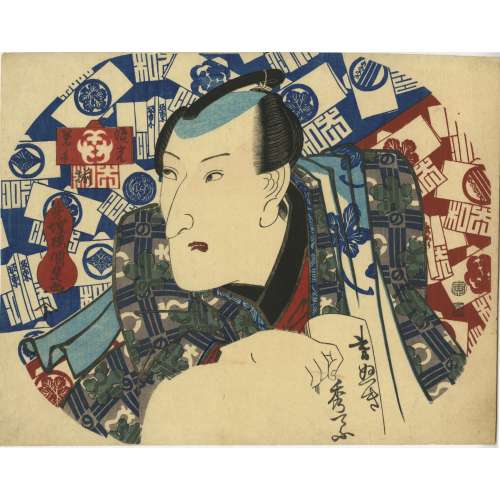 Artist: Utagawa Kunisada [歌川 国貞] a.k.a. Utagawa Toyokuni III [三代歌川豊国] (Japanese, 1786 – 1865). Signed: Kochoro Kuisada ga [香蝶楼国貞画] in a red double-gourd cartouche Publisher: Enshūya Matabei [遠州屋又兵衛] (Japanese, fl. c. 1768 – 1881). Series: Fashionable Youths [流行若手揃] (Ryuko Wakate Zoroi). Actor: Bandō Minosuke II [坂東蓑助] (Japanese, 1802 – 1863); other names: Morita Kan'ya XI, Bandô Mitsugorō IV. Date-kiwame seals: Bunsei 13 / Tenpō 1 (1830). One more print from the same series (See Waseda 201-2125); not in this collection: Segawa Kikunojō V [瀬川菊之丞] (Japanese, 1802 – 1832); other names: Segawa Tamon I.
Artist: Utagawa Kunisada [歌川 国貞] a.k.a. Utagawa Toyokuni III [三代歌川豊国] (Japanese, 1786 – 1865). Signed: Kochoro Kuisada ga [香蝶楼国貞画] in a red double-gourd cartouche Publisher: Enshūya Matabei [遠州屋又兵衛] (Japanese, fl. c. 1768 – 1881). Series: Fashionable Youths [流行若手揃] (Ryuko Wakate Zoroi). Actor: Bandō Minosuke II [坂東蓑助] (Japanese, 1802 – 1863); other names: Morita Kan'ya XI, Bandô Mitsugorō IV. Date-kiwame seals: Bunsei 13 / Tenpō 1 (1830). One more print from the same series (See Waseda 201-2125); not in this collection: Segawa Kikunojō V [瀬川菊之丞] (Japanese, 1802 – 1832); other names: Segawa Tamon I.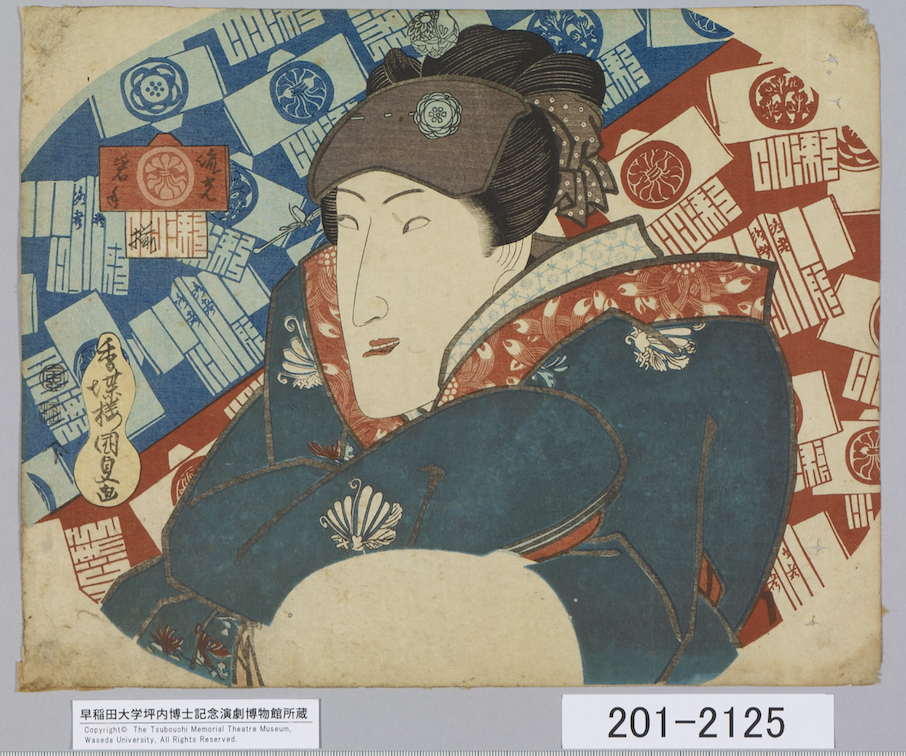
-
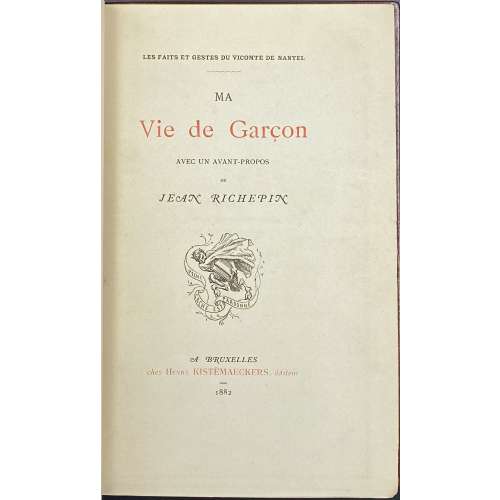 The text attributed to Claude-Prosper Jolyot de Crébillon, dit Crébillon fils (French, 1707 – 1777) or to Anne Claude de Caylus (French, 1692 – 1765). A hardcover volume, 21 x 13.5 cm, collated in-12mo, bound by H. Blanchetière in full crushed brown morocco, spine with raised bands, gilt lettering “VICOMTE | DE NANTEL | – | MA VIE | DE | GARÇON” and “BRUXELLES | 1882” in the bottom compartment; gilt double-fillet to cover margins, six gilt fillets inside, woven silk endpapers, marbled flyleaves, original publisher’s wrappers preserved; the bookplate of Henri Bosc to f.e.p. verso (monogrammed by Martin Van Maële), bookplate of J.-P. Dutel to flyleaf, 18 x 9 cm manuscript list of illustrations tipped in (lettered “12 aquarelles originales | de Martin Van Maële” on top), all margins gilt; printed on tinted paper. Collation: [1] front wrapper lettered in red and black, [1] half-title with limitation to verso, frontispiece by Amédée Lynen, verso inscribed by Van Maële to Bosc, meaning “A jewel for a most sympathetic and sensitive connoisseur Mr H. Bosc”, signed; [1] t.p. in red and black/blank, 06 (pp. [i]-xii) Avant-propos by Jean Richepin, 1-116 (pp. [5]-116) 124 (pp. 117-143, [144] colophon) [1] back wrapper w/advert (Extrait de Gil Blas), spine w/price 10 Fr.; 12 watercolours by Van Maële extraneous to collation, all signed “with his full name in a flowery script”, as per S. A. Perry. Title-page / Cover (red and black): LES FAITS ET GESTES DU VICOMTE DE NANTEL | ~ | MA | Vie de Garçon | AVEC UN AVANT-PROPOS | DE | JEAN RICHEPIN | {publisher’s device} | A BRUXELLES | Chez Henry KISTEMAECKERS, éditeur | – | 1882 || Worldcat : xii, 143 pages frontispiece 20 cm; OCLC Number / Unique Identifier: 5887998. Limitation: 300 copies on papier teinté, 10 copies on papeir du Japon. This is a unique copy enriched with 12 original watercolours by Martin Van Maële. Colophon: ACHEVÉ D’IMPIMER | le 30 mai 1882. | par A. LEFÈVRE, a BRUXELLES | {printer’s device} | POUR | Henry Kistemaeckers, Editeur | à Bruxelles. || Catalogue raisonné: S. A. Perry (2015) № 89 / [LIB-2920.2022] Sheryl A. Perry. Martin van Maële: An illustrated bibliographical checklist. — Las Vegas, 2021. Ref: The Erotica Bibliophile. Contributors: Jean Richepin (French, 1849 – 1926) – author (avant-propos). Maurice François Alfred Martin van Maële [Martin van Maële] (French, 1863 – 1926) – artist. Amédée Ernest Lynen (French, 1852 – 1938) – artist (frontispiece). Henry Kistemaeckers (Belgian, 1851–1934) – publisher. Henri Bosc [Henri Marie Joseph Danviolet] (French, 1884 – 1967) – provenance. J.-P. Dutel description: [Claude-Prosper Jolyot de CRÉBILLON ?]. LES FAITS ET GESTES DU VICOMTE DE NANTEL. MA VIE DE GARÇON. Avec un avant-propos de Jean Richepin. Bruxelles, Henry Kistemaeckers. 1882. In-8 (202 x 120 mm) de XII, 143 pp. et [1] p. Maroquin brun, dos à 5 nerfs, filets dorés sur les coupes et les bordures intérieures, tranches dorées, gardes en moire, double-gardes en papier, couverture et dos conservés. (H. Blanchetière). Le texte est attribué à Claude-Prosper Jolyot de Crébillon, dit Crébillon fils, (1707-1777). Cette édition fut publiée en 1882 à Bruxelles par Kistemaeckers et est ornée d’unfrontispice d’A. Lynen. TIRAGE : 10 ex. sur japon. 500 ex. sur papier teinté. UN DES 500 EXEMPLAIRES SUR PAPIER TEINTÉ ORNÉ DE 12 AQUARELLES ORIGINALES HORSTEXTE SIGNÉES PAR MARTIN VAN MAELE.
The text attributed to Claude-Prosper Jolyot de Crébillon, dit Crébillon fils (French, 1707 – 1777) or to Anne Claude de Caylus (French, 1692 – 1765). A hardcover volume, 21 x 13.5 cm, collated in-12mo, bound by H. Blanchetière in full crushed brown morocco, spine with raised bands, gilt lettering “VICOMTE | DE NANTEL | – | MA VIE | DE | GARÇON” and “BRUXELLES | 1882” in the bottom compartment; gilt double-fillet to cover margins, six gilt fillets inside, woven silk endpapers, marbled flyleaves, original publisher’s wrappers preserved; the bookplate of Henri Bosc to f.e.p. verso (monogrammed by Martin Van Maële), bookplate of J.-P. Dutel to flyleaf, 18 x 9 cm manuscript list of illustrations tipped in (lettered “12 aquarelles originales | de Martin Van Maële” on top), all margins gilt; printed on tinted paper. Collation: [1] front wrapper lettered in red and black, [1] half-title with limitation to verso, frontispiece by Amédée Lynen, verso inscribed by Van Maële to Bosc, meaning “A jewel for a most sympathetic and sensitive connoisseur Mr H. Bosc”, signed; [1] t.p. in red and black/blank, 06 (pp. [i]-xii) Avant-propos by Jean Richepin, 1-116 (pp. [5]-116) 124 (pp. 117-143, [144] colophon) [1] back wrapper w/advert (Extrait de Gil Blas), spine w/price 10 Fr.; 12 watercolours by Van Maële extraneous to collation, all signed “with his full name in a flowery script”, as per S. A. Perry. Title-page / Cover (red and black): LES FAITS ET GESTES DU VICOMTE DE NANTEL | ~ | MA | Vie de Garçon | AVEC UN AVANT-PROPOS | DE | JEAN RICHEPIN | {publisher’s device} | A BRUXELLES | Chez Henry KISTEMAECKERS, éditeur | – | 1882 || Worldcat : xii, 143 pages frontispiece 20 cm; OCLC Number / Unique Identifier: 5887998. Limitation: 300 copies on papier teinté, 10 copies on papeir du Japon. This is a unique copy enriched with 12 original watercolours by Martin Van Maële. Colophon: ACHEVÉ D’IMPIMER | le 30 mai 1882. | par A. LEFÈVRE, a BRUXELLES | {printer’s device} | POUR | Henry Kistemaeckers, Editeur | à Bruxelles. || Catalogue raisonné: S. A. Perry (2015) № 89 / [LIB-2920.2022] Sheryl A. Perry. Martin van Maële: An illustrated bibliographical checklist. — Las Vegas, 2021. Ref: The Erotica Bibliophile. Contributors: Jean Richepin (French, 1849 – 1926) – author (avant-propos). Maurice François Alfred Martin van Maële [Martin van Maële] (French, 1863 – 1926) – artist. Amédée Ernest Lynen (French, 1852 – 1938) – artist (frontispiece). Henry Kistemaeckers (Belgian, 1851–1934) – publisher. Henri Bosc [Henri Marie Joseph Danviolet] (French, 1884 – 1967) – provenance. J.-P. Dutel description: [Claude-Prosper Jolyot de CRÉBILLON ?]. LES FAITS ET GESTES DU VICOMTE DE NANTEL. MA VIE DE GARÇON. Avec un avant-propos de Jean Richepin. Bruxelles, Henry Kistemaeckers. 1882. In-8 (202 x 120 mm) de XII, 143 pp. et [1] p. Maroquin brun, dos à 5 nerfs, filets dorés sur les coupes et les bordures intérieures, tranches dorées, gardes en moire, double-gardes en papier, couverture et dos conservés. (H. Blanchetière). Le texte est attribué à Claude-Prosper Jolyot de Crébillon, dit Crébillon fils, (1707-1777). Cette édition fut publiée en 1882 à Bruxelles par Kistemaeckers et est ornée d’unfrontispice d’A. Lynen. TIRAGE : 10 ex. sur japon. 500 ex. sur papier teinté. UN DES 500 EXEMPLAIRES SUR PAPIER TEINTÉ ORNÉ DE 12 AQUARELLES ORIGINALES HORSTEXTE SIGNÉES PAR MARTIN VAN MAELE. -
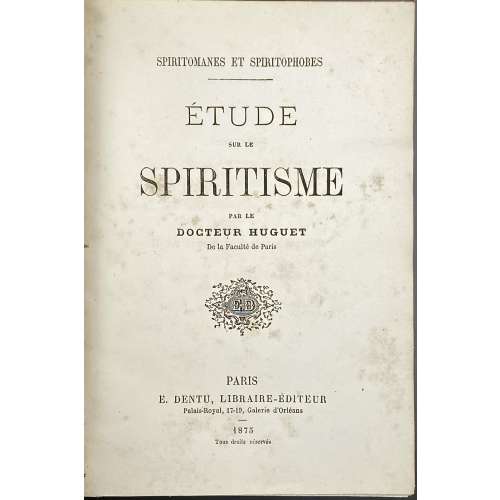 Hardcover volume 20 x 14 cm, bound in burgundy half faux chagrin over brown faux chagrin boards, gilt lettering to spine, marbled endpapers, all margins sprinkled blue. Convolute: 1) SPIRITOMANES ET SPIRITOPHOBES |— | ÉTUDE | SUR LE | SPIRITISME | PAR LE | DOCTEUR HUGUET | De la Faculté de Paris | {« ED » publsiher’s device} | PARIS | E. DENTU, LIBRAIRE-ÉDUTEUR | Palais-Royal, 17-19, Galerie d’Orléans | – | 1875 | Tous droits réservés ||; pp. [1-7] 8-48, with Dr Huguet signature to h.t. verso. Contents: Introduction. I. Le procès du 16 juin 1875; MM. Firman, Buguet, Leymarie. II. Le Spiritisme dans ses rapports avec le dogme, l’histoire, la science. Conclusion. 2) Same, pp. [1-7] 8-48, with Dr Huguet signature to h.t. verso. 3) FÉDÉRATION SPIRITE BELGE | — | Étude critique | DU LIVRE INTITULÉ | L'Hypnotisme | et le Spiritisme | du Docteur Joseph LAPPONI | Médecin de L. L. S. S. LÉON XIII et PIE X. | * | CONFÉRENCE | PAR | J. FRAIKIN | Président de la Fédération Spirite de Liége, | Vice-Président de la Fédération Spirite Belge. | * | Imp. Emile Dumon | Rue Haute-Marexhe, 27, Herstal-Liége. ||; pp. [1-3] 4-50 [51] errata/blank. 4) BUREAU PERMANENT D’ÉTUDE | DES | PHÉNOMÈNES SPIRITES | ANVERS | * | Cours De Doctrine Spirite | — | Imprimerie et Publicité « LA GÉNÉRALE » (SOC. AN.) Anvers. ||; 6 leaves, pagination trimmed out with partly visible numbers 13 and 18 ; includes Deuxième leçon « Du passage de la vie… », t.p., 7 pp. of text, last three pages blank. 5) LA PSYCHOLOGIE EXPERIMENTALE || Manifeste adresse par le « Syndicat de la Presse spiritualiste de France » | au Congres spiritualiste de Londres (Juin 1898); pp. [1] 2-31 [32]. Contents: I. Prolégomènes. II. Télépathie. III. Médiumnité. Conclusion. 6) LE FLUIDE HUMAIN | Son existence/ | Ses lois * Ses propriétés | — | CONFÉRENCE | DONNÉE PAR LE | Sous-Lieutenant DE BACKERE | — ||; pp. [1-3] 4-28. Contributors: Hilarion Huguet (French, ? – ?) Alfred-Henri Firman (American, ? – ?) Édouard Isidore Buguet (1840 – 1901) Pierre-Gaëtan Leymarie (1827 – 1901) Giuseppe Lapponi (Italian, 1851 – 1906) Jacques Fraikin (Belgian, ? – ?) Franz de Backere (Belgian, ? – ?)
Hardcover volume 20 x 14 cm, bound in burgundy half faux chagrin over brown faux chagrin boards, gilt lettering to spine, marbled endpapers, all margins sprinkled blue. Convolute: 1) SPIRITOMANES ET SPIRITOPHOBES |— | ÉTUDE | SUR LE | SPIRITISME | PAR LE | DOCTEUR HUGUET | De la Faculté de Paris | {« ED » publsiher’s device} | PARIS | E. DENTU, LIBRAIRE-ÉDUTEUR | Palais-Royal, 17-19, Galerie d’Orléans | – | 1875 | Tous droits réservés ||; pp. [1-7] 8-48, with Dr Huguet signature to h.t. verso. Contents: Introduction. I. Le procès du 16 juin 1875; MM. Firman, Buguet, Leymarie. II. Le Spiritisme dans ses rapports avec le dogme, l’histoire, la science. Conclusion. 2) Same, pp. [1-7] 8-48, with Dr Huguet signature to h.t. verso. 3) FÉDÉRATION SPIRITE BELGE | — | Étude critique | DU LIVRE INTITULÉ | L'Hypnotisme | et le Spiritisme | du Docteur Joseph LAPPONI | Médecin de L. L. S. S. LÉON XIII et PIE X. | * | CONFÉRENCE | PAR | J. FRAIKIN | Président de la Fédération Spirite de Liége, | Vice-Président de la Fédération Spirite Belge. | * | Imp. Emile Dumon | Rue Haute-Marexhe, 27, Herstal-Liége. ||; pp. [1-3] 4-50 [51] errata/blank. 4) BUREAU PERMANENT D’ÉTUDE | DES | PHÉNOMÈNES SPIRITES | ANVERS | * | Cours De Doctrine Spirite | — | Imprimerie et Publicité « LA GÉNÉRALE » (SOC. AN.) Anvers. ||; 6 leaves, pagination trimmed out with partly visible numbers 13 and 18 ; includes Deuxième leçon « Du passage de la vie… », t.p., 7 pp. of text, last three pages blank. 5) LA PSYCHOLOGIE EXPERIMENTALE || Manifeste adresse par le « Syndicat de la Presse spiritualiste de France » | au Congres spiritualiste de Londres (Juin 1898); pp. [1] 2-31 [32]. Contents: I. Prolégomènes. II. Télépathie. III. Médiumnité. Conclusion. 6) LE FLUIDE HUMAIN | Son existence/ | Ses lois * Ses propriétés | — | CONFÉRENCE | DONNÉE PAR LE | Sous-Lieutenant DE BACKERE | — ||; pp. [1-3] 4-28. Contributors: Hilarion Huguet (French, ? – ?) Alfred-Henri Firman (American, ? – ?) Édouard Isidore Buguet (1840 – 1901) Pierre-Gaëtan Leymarie (1827 – 1901) Giuseppe Lapponi (Italian, 1851 – 1906) Jacques Fraikin (Belgian, ? – ?) Franz de Backere (Belgian, ? – ?) -
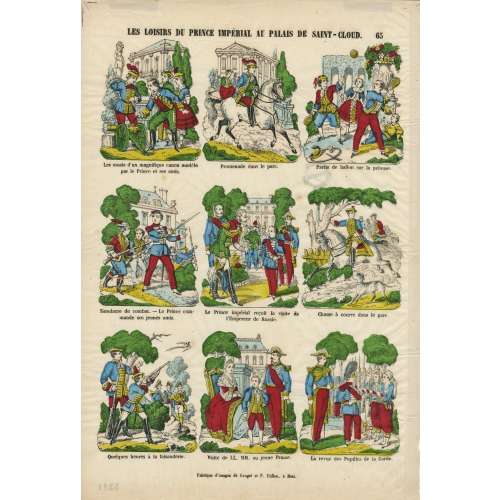 Hand-coloured woodcut on wove paper, 400 x 280 mm; black ink stamp “5321” to reverse. Top: "LES LOISIRS DU PRINCE IMPERIAL AU PALAIS DE SAINT- CLOUD" — "65". Below: nine cartoons with captions.
Hand-coloured woodcut on wove paper, 400 x 280 mm; black ink stamp “5321” to reverse. Top: "LES LOISIRS DU PRINCE IMPERIAL AU PALAIS DE SAINT- CLOUD" — "65". Below: nine cartoons with captions.- Les essais d'un magnifique canon modèle par le Prince et ses amis.
- Promenade dans le parc.
- Partie de ballon sur la pelouse.
- Simulacre de combat. — Le Prince commande ses jeunes amis.
- le Prince impérial reçoit la visite de l'Empereur de Russie.
- Chasse à courre dans le parc.
- Quelques heures à la faisanderie.
- Visite de LL. MM. au jeune Prince.
- La revue des Pupilles de la Garde.
-
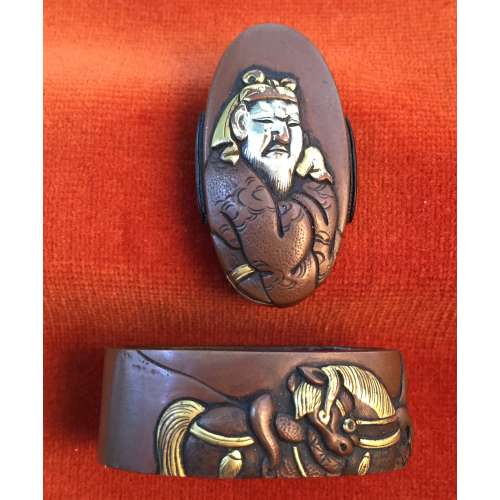 Fuchi: 38 x 22 x 14 mm. Kashira: 33 x 18 x 9 mm Techniques: Usu-shishiai-bori (薄肉合彫) – low-relief, zogan.
Fuchi: 38 x 22 x 14 mm. Kashira: 33 x 18 x 9 mm Techniques: Usu-shishiai-bori (薄肉合彫) – low-relief, zogan. -
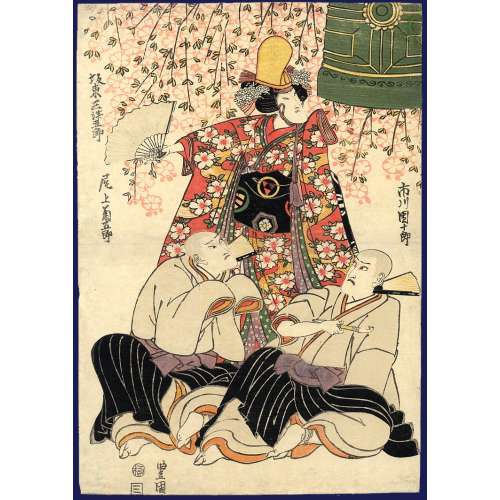 Artist: Utagawa Toyokuni I (1769–1825) Title: Actors Bando Mitsugorō, Ichikawa Danjūrō, Onoe Kikugorō in play The Maiden at Dōjō Temple. Presumably Bunka 13 (1816) at Nakamura Theater in Edo. Publisher: Mikawaya Seiemon (c. 1805-1829); Marks' "Publishers" № 328, p. 235. Size: Vertical ôban MEDIUM OR TECHNIQUE: Woodblock print (nishiki-e); ink and color on paper. Signed: Toyokuni ga Censor's seal: kiwame Detailed discussion on the topic can be seen at: The Maiden at Dōjō Temple
Artist: Utagawa Toyokuni I (1769–1825) Title: Actors Bando Mitsugorō, Ichikawa Danjūrō, Onoe Kikugorō in play The Maiden at Dōjō Temple. Presumably Bunka 13 (1816) at Nakamura Theater in Edo. Publisher: Mikawaya Seiemon (c. 1805-1829); Marks' "Publishers" № 328, p. 235. Size: Vertical ôban MEDIUM OR TECHNIQUE: Woodblock print (nishiki-e); ink and color on paper. Signed: Toyokuni ga Censor's seal: kiwame Detailed discussion on the topic can be seen at: The Maiden at Dōjō Temple -
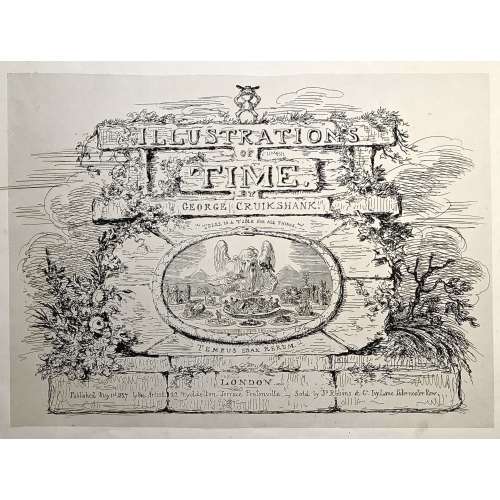
Engraved title page: ILLUSTRATION | OF | TIME. | GEORGE CRUIKSHANK. | "THERE IS A TIME FOR ALL THINGS". | TEMPUS EDAX RERUM. | LONDON | Published May 1st 1827 by the Artist - 22 Myddelton Terrace Pentonville. - Sold by Js. Robins & Co. Ivy Lane Paternoster Row.
Oblong folio, 33.5 x 44 cm. Engraved vignette title page and six not-coloured engraved plates with multiple images showing thirty-five humorous scenes.
First edition, first issue. Uncoloured. Pristine condition.
Half-leather bound in marbled cardboard and red morocco and gild lettering and arabesque. Frontispiece and 6 plates with protective tissues.
Content:1. Time-Called & Time-Come (five sketches)
2. Behind Time (seven sketches)
3. Time Thrown Away (six sketches)
4. Hard Times [&] Term Time (five sketches)
5. Time Badly Employed (five sketches)
6. Christmas Time (seven sketches)
British Museum № 1978,U.3026.1. BM description: "Frontispiece, the title on a background of symmetrical but dilapidated and grass-grown masonry. On the summit stands a little laughing gnome, with a wide hat and a body formed of an hour-glass; Inset is an oval bordered by a serpent with its tail in its mouth (emblem of eternity), in which is an aged and all-devouring Time (bald except for a forelock), seated behind a table whose surface is the base of the design. He puts to his mouth a fork on which is speared an elephant with a castle on its back containing tiny figures with spears. In his r. hand is a spoon containing a country church. His table is covered with dishes, and at his r. hand is a sickle. The central and biggest dish is heaped with a jumble of tiny objects: crown, table, chair, wheelbarrow, picture; round the room sit little figures: a soldier, parson, lady and child, &c. The ten other dishes contain: an antique glass coach with horses and footmen; an overladen camel beside a palm-tree; ruins of a castle; a farmhouse; a shepherd and sheep; a dismantled cannon and balls, cattle, a man-of-war in full sail; a ruinous Gothic cathedral; a clump of trees (the last two are dominated by a large decanter). Below Time are two (Egyptian) pyramids. Above: 'There Is A Time For All Things'; below: 'Tempus Edax Rerum'. 1 May 1827. Etching."Bibliography:- Reid, G W, A descriptive catalogue of the works of George Cruikshank, London, 1871.
- Stephens, Frederic George; George, Mary Dorothy, Catalogue of Political and Personal Satires in the Department of Prints and Drawings in the British Museum, 11 vols, London, BMP, 1870.
- Cohn, A M, George Cruikshank, catalogue raisonné, London, 1924.
-
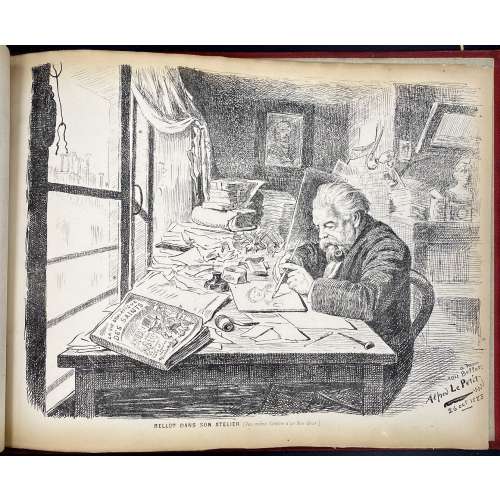 An album of the "Le Bon-Bock" dinners for the year 1884. Author, designer and publisher – Emile Bellot (French, 1831 – 1886), a Parisian artist and engraver. "Le Bon-Bock" was a monthly dinner of artists and men of letters, who gathered in Paris for good food, good company, and artistic performances, from 1875 to at least 1925. The story behind these gatherings as told by Emile Bellot, the founder, is this:
An album of the "Le Bon-Bock" dinners for the year 1884. Author, designer and publisher – Emile Bellot (French, 1831 – 1886), a Parisian artist and engraver. "Le Bon-Bock" was a monthly dinner of artists and men of letters, who gathered in Paris for good food, good company, and artistic performances, from 1875 to at least 1925. The story behind these gatherings as told by Emile Bellot, the founder, is this:In February 1875, Pierre Cottin1 came to me and said: 'I discovered a poet and tragedian of immense talent and who interprets the poems of the Great Victor Hugo in an astonishing way. Monsieur Gambini. I promised him that I would make it heard by an audience of artists and men of letters. I am counting on you who have many connections to keep my promise to him'. I gathered about 25 of my friends and acquaintances in a picnic dinner which took place at a restaurant 'Krauteimer' on the rue Rochechouart in Montmartre. They heard from Mr Gambini first, then my friends Étienne Carjat2, J. Gros3, Adrien Dézamy4, etc. performed. These gentlemen completed the evening so brilliantly that it was unanimously decided that we would start a similar dinner every month. Poets, musicians, men of letters, singers would be invited to this dinner. I was in charge of the organization of this little party and as it was the dream of my life to bring together old comrades, I was careful not to refuse and I pursued this good idea. Cottin and René Tener5 were kind enough to help me in this joyous task and especially my old friend Carjat. The following March began our 1st monthly dinner.
The name "Le Bon-Bock" means "The Good Bock", whilst Bock is a kind of beer, a dark, malty, lightly hopped ale. The dinner was named "Le Bon-Bock" in honour of the Éduard Manet painting (1873), a famous portrait of Emile Bellot, called "Le Bon-Bock".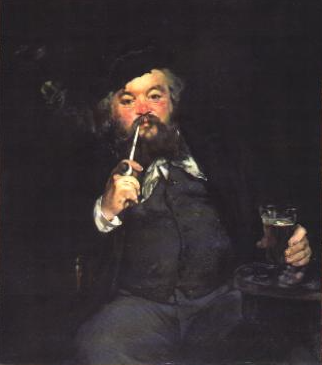 The invitations to the dinner were also produced by the artists and looked like this one by Alexandre Ferdinandus (October 3, 1883).
The invitations to the dinner were also produced by the artists and looked like this one by Alexandre Ferdinandus (October 3, 1883).
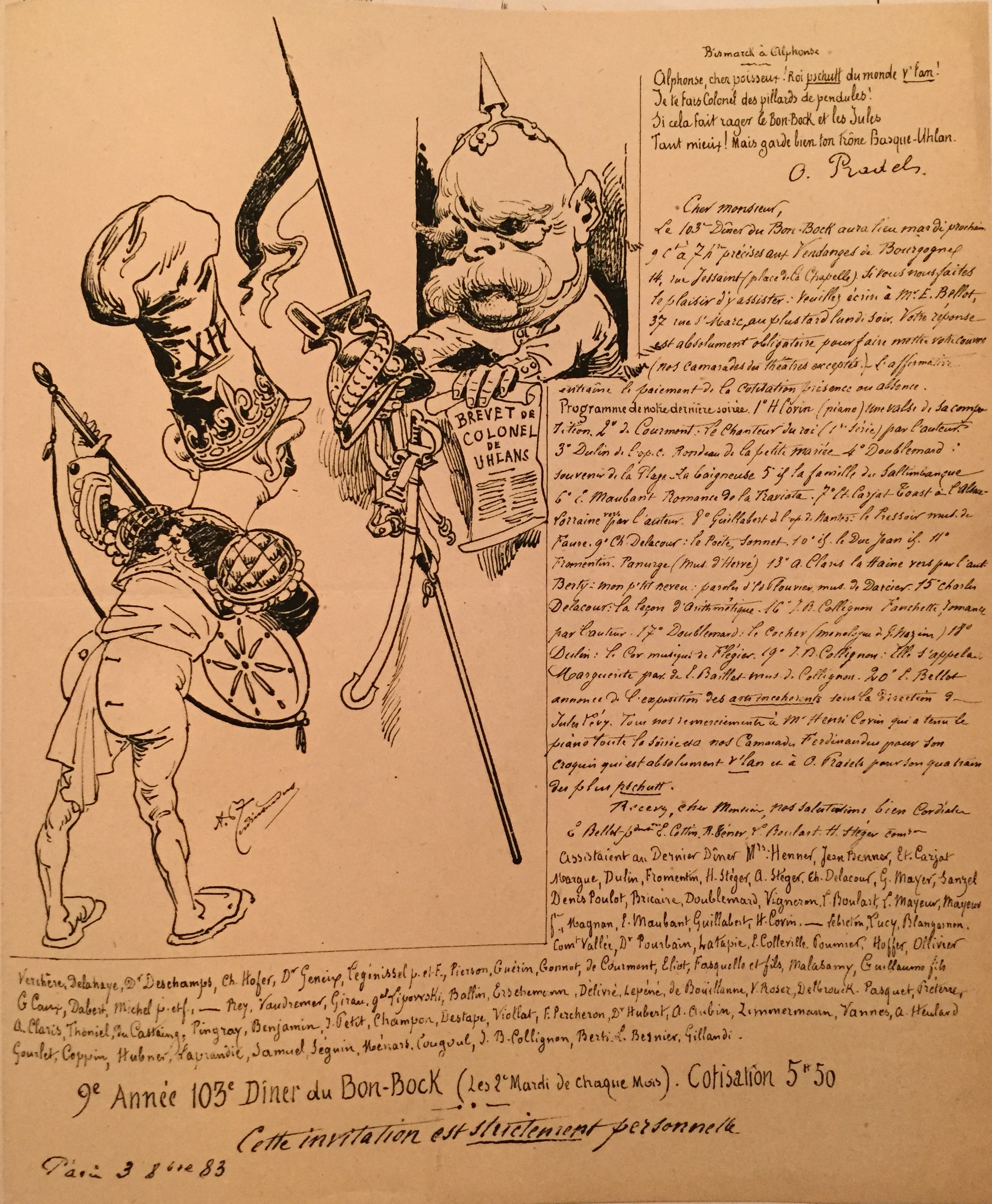 Besides this sketch of the Parisian social and artistic life at the end of the 19th century, the provenance of the album in our collection generates additional interest. The ink stamp to the front flyleaf reads: "Docteur Henry Uzan, 29 Avenue Perrichont, Paris XVI".
Doctor Henry Uzan was Jewish. He was arrested by the Pétain police on October 1, 1941, and interned in Drancy. With the few means at his disposal, he undertook to treat the sick whom he then saw leaving, week after week, towards their terrible destiny in the extermination camps. In October 1943 doctor Uzan was deported to the island of Alderney. After the Normandy Landing of June 6, 1944, Nazis evacuated the island detainees and transfer them to the Neuengamme camp, via northern France and Belgium. During the transfer, doctor Uzan managed to escape from the train on the night of September 3 to 4 around Dixmude in Flanders. He was taken in by the Belgian Resistance, which he joined before being repatriated to France.
In France, he continued working as a physician and was one of the founders of Association des internés et déportés politiques (AIDP). In 1945, together with his friends, the doctor designed the symbol for the Fédération nationale des déportés et internés résistants et patriotes:
Besides this sketch of the Parisian social and artistic life at the end of the 19th century, the provenance of the album in our collection generates additional interest. The ink stamp to the front flyleaf reads: "Docteur Henry Uzan, 29 Avenue Perrichont, Paris XVI".
Doctor Henry Uzan was Jewish. He was arrested by the Pétain police on October 1, 1941, and interned in Drancy. With the few means at his disposal, he undertook to treat the sick whom he then saw leaving, week after week, towards their terrible destiny in the extermination camps. In October 1943 doctor Uzan was deported to the island of Alderney. After the Normandy Landing of June 6, 1944, Nazis evacuated the island detainees and transfer them to the Neuengamme camp, via northern France and Belgium. During the transfer, doctor Uzan managed to escape from the train on the night of September 3 to 4 around Dixmude in Flanders. He was taken in by the Belgian Resistance, which he joined before being repatriated to France.
In France, he continued working as a physician and was one of the founders of Association des internés et déportés politiques (AIDP). In 1945, together with his friends, the doctor designed the symbol for the Fédération nationale des déportés et internés résistants et patriotes:
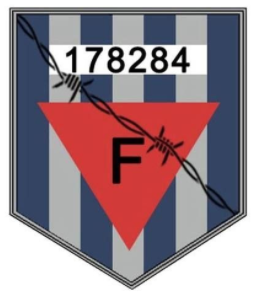 The story behind the number on the emblem (178284) is fascinating but it is out of the scope of this material.
The story behind the number on the emblem (178284) is fascinating but it is out of the scope of this material.
1. Pierre Cottin (French, 1823 – c. 1887) – Engraver, mezzotinter, genre and landscape painter; born in Chappelle-Saint-Denis (near Paris), a pupil of Jazet. Exhibited at the Salon from 1845, also in London from 1876 to 1879.↩ 2. Étienne Carjat (French, 1828 – 1906) – Journalist, caricaturist and photographer. ↩ 3. Jean Baptiste Louis Gros (French, 1793 – 1870) – Painter. ↩ 4. Adrien Dézamy (French, 1844 – 1891) – Writer, poet, general secretary of the Théâtre des Bouffes in Paris. ↩ 5. Rene Tener (French, 1846 – 1925) – Painter. ↩ Sources:Auguste Lepage. Les dîners artistiques et littéraires de Paris / Bibliothèque des Deux mondes (2e éd.) – Paris: Frinzine, Klein et Cie., 1884. [Accession № LIB-2606.2021 in this collection]
-
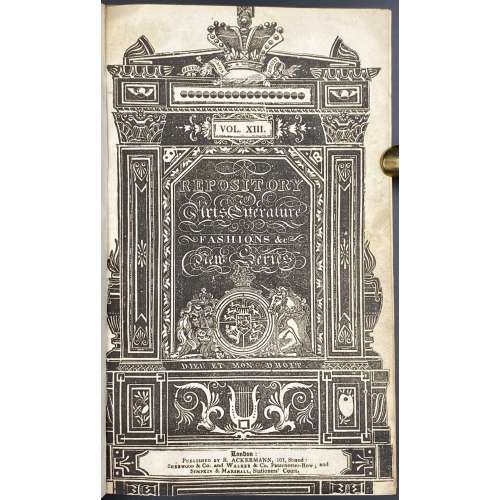 Pagination: [2] – letterpress title / blank, t.p. with contents / to readers, [1] 2-376 + 7 b/w and 16 coloured plates (total 23); this differs to Abbey’s description of 372 pages + 4 pages index, and 41 plates (lacking 18 plates). In No 73 lacking 3 plates: Quadrant Regent st., Morning dress and Full dress. In No 74 lacking 5 plates: Charles str., Brienz, head dresses, full dress, and muslin patterns. In No 75 lacking 5 plates: 4 with bank notes and Castle of Rinkenberg. In No 76 lacking 1 plate: Cavern St. Beat. In No 77 lacking 2 plates: Wetzar and Lake Thun. In No 78 lacking 2 plates: Crescent at Portland Place and Environs of Thun. Collation: 4to; letterpress title, [A]1 B-Z4 Aa-Zz4 3A-3C4 3D2. Binding: 23.5 x 15.5 cm; double fillet blind-ruled half-calf over pebbled cloth boards, raised bands ruled blind, crimson label with gilt lettering to spine. References: Martin Hardie (1906), p.310 [LIB-2623.2021]; R. V. Tooley (1935), p. 26 [LIB-2641.2021]; J. R. Abbey (1953), Cat. № 212, p. 174 [LIB-2622.2021].
Pagination: [2] – letterpress title / blank, t.p. with contents / to readers, [1] 2-376 + 7 b/w and 16 coloured plates (total 23); this differs to Abbey’s description of 372 pages + 4 pages index, and 41 plates (lacking 18 plates). In No 73 lacking 3 plates: Quadrant Regent st., Morning dress and Full dress. In No 74 lacking 5 plates: Charles str., Brienz, head dresses, full dress, and muslin patterns. In No 75 lacking 5 plates: 4 with bank notes and Castle of Rinkenberg. In No 76 lacking 1 plate: Cavern St. Beat. In No 77 lacking 2 plates: Wetzar and Lake Thun. In No 78 lacking 2 plates: Crescent at Portland Place and Environs of Thun. Collation: 4to; letterpress title, [A]1 B-Z4 Aa-Zz4 3A-3C4 3D2. Binding: 23.5 x 15.5 cm; double fillet blind-ruled half-calf over pebbled cloth boards, raised bands ruled blind, crimson label with gilt lettering to spine. References: Martin Hardie (1906), p.310 [LIB-2623.2021]; R. V. Tooley (1935), p. 26 [LIB-2641.2021]; J. R. Abbey (1953), Cat. № 212, p. 174 [LIB-2622.2021]. -
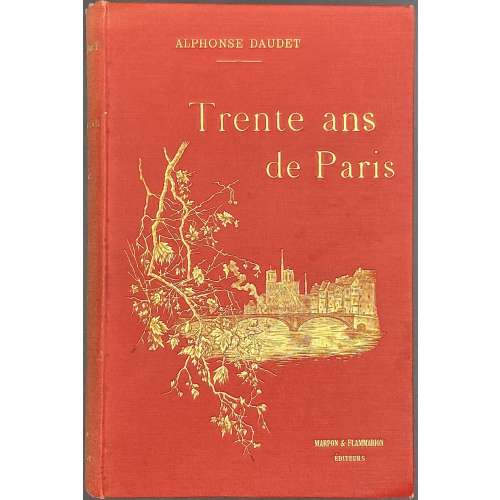 Pictorial title (coloured): Collection Artistique Guillaume et Cie |—| ALPHONSE DAUDET | Trente ans | de Paris | PARIS | C. MARPON ET E. FLAMMARION | 26, RUE RACINE, 26 | 1888 || Title page: Collection Artistique Guillaume et Cie |—| ALPHONSE DAUDET | Trente ans de Paris | À TRAVERS MA VIE ET MES LIVRES | Illustré | PAR BIELER, MONTÉGUT, MYRBACH, PICARD ET ROSSI | Gravure de Guillaume Frères et Cie | PARIS | C. MARPON ET E. FLAMMARION | 26, RUE RACINE, 26 | 1888 | Tous droits réservés. || Pagination: [12] [1] 2-344 [6], total 362 pp., in-text illustration, head- and tailpieces, photomechanical reproductions. Collation: 12mo; π6, 1-2812 +1; total 181 leaves. Binding: 19 x 12.5 cm; red cloth, gilt lettering to spine, gilt lettering and vignette to front board and gilt device to back board; bookplate to front pastedown: Ex Libris Dr. Vodoz = Egg; Gift inscription to flyleaf in German, dated 30/12/87. Contributors: Alphonse Daudet (French, 1840 – 1897) – author. Ernest Biéler (Swiss, 1863 – 1948) – artist. Louis Montégut (French, 1855 – 1906) – artist. Felician Myrbach (Austrian, 1853 – 1940) – artist. Georges Picard (French, 1857 – 1943) – artist. Luigi Rossi (Swiss, 1853 – 1923) – artist. Ernest Flammarion (French, 1846 – 1936) – publisher. Charles Marpon (French, 1838 – 1890) – publisher. Alexis Lahure (French, 1849 – 1928) – printer. Guillaume Frères et Cie – engravers.
Pictorial title (coloured): Collection Artistique Guillaume et Cie |—| ALPHONSE DAUDET | Trente ans | de Paris | PARIS | C. MARPON ET E. FLAMMARION | 26, RUE RACINE, 26 | 1888 || Title page: Collection Artistique Guillaume et Cie |—| ALPHONSE DAUDET | Trente ans de Paris | À TRAVERS MA VIE ET MES LIVRES | Illustré | PAR BIELER, MONTÉGUT, MYRBACH, PICARD ET ROSSI | Gravure de Guillaume Frères et Cie | PARIS | C. MARPON ET E. FLAMMARION | 26, RUE RACINE, 26 | 1888 | Tous droits réservés. || Pagination: [12] [1] 2-344 [6], total 362 pp., in-text illustration, head- and tailpieces, photomechanical reproductions. Collation: 12mo; π6, 1-2812 +1; total 181 leaves. Binding: 19 x 12.5 cm; red cloth, gilt lettering to spine, gilt lettering and vignette to front board and gilt device to back board; bookplate to front pastedown: Ex Libris Dr. Vodoz = Egg; Gift inscription to flyleaf in German, dated 30/12/87. Contributors: Alphonse Daudet (French, 1840 – 1897) – author. Ernest Biéler (Swiss, 1863 – 1948) – artist. Louis Montégut (French, 1855 – 1906) – artist. Felician Myrbach (Austrian, 1853 – 1940) – artist. Georges Picard (French, 1857 – 1943) – artist. Luigi Rossi (Swiss, 1853 – 1923) – artist. Ernest Flammarion (French, 1846 – 1936) – publisher. Charles Marpon (French, 1838 – 1890) – publisher. Alexis Lahure (French, 1849 – 1928) – printer. Guillaume Frères et Cie – engravers. -
 Hand-coloured etching by an anonymous British artist, printed on May 26, 1829, in London. Description by British Museum (1868,0808.8988): "O'Connell, in wig and gown, walks to the left from the massive door of a small stone building, stooping, and holding his handkerchief to his right eye. He wails: 'O, my poor Seat! my poor Seat! my poor Seat! I'd have given any thing for a seat.' In the doorway (right) stands Peel, saying with wary blandness: 'What good can weeping do you Dan.—I'm sure I did as much as I could!!' Above the large knocker on the plank door is 'Knock & Ring'. There is a projecting bell, above a placard: 'NB. Jews or Proselytes desirous of Obtaining Seats in the House may Knock and Ring at this Door.' One corner of "the House", a small stone shed, is depicted. O'Connell is walking towards a strip of water, across which is a mountain, with a board pointing 'To — Clare'. Comment by BM: "Catholic Emancipation raised high hopes among Jews; the first Bill, after a petition from Jews in Liverpool, was introduced 15 Apr. 1830, but Jewish Emancipation did not become law till 1858." Inscription under the frame with title, "A. Sharpshooter fec", text within image and publication line: "Pub. by G. Humphrey, 24 St. James's Street May 26 1829". Size: 37.5 x 26 cm.
Hand-coloured etching by an anonymous British artist, printed on May 26, 1829, in London. Description by British Museum (1868,0808.8988): "O'Connell, in wig and gown, walks to the left from the massive door of a small stone building, stooping, and holding his handkerchief to his right eye. He wails: 'O, my poor Seat! my poor Seat! my poor Seat! I'd have given any thing for a seat.' In the doorway (right) stands Peel, saying with wary blandness: 'What good can weeping do you Dan.—I'm sure I did as much as I could!!' Above the large knocker on the plank door is 'Knock & Ring'. There is a projecting bell, above a placard: 'NB. Jews or Proselytes desirous of Obtaining Seats in the House may Knock and Ring at this Door.' One corner of "the House", a small stone shed, is depicted. O'Connell is walking towards a strip of water, across which is a mountain, with a board pointing 'To — Clare'. Comment by BM: "Catholic Emancipation raised high hopes among Jews; the first Bill, after a petition from Jews in Liverpool, was introduced 15 Apr. 1830, but Jewish Emancipation did not become law till 1858." Inscription under the frame with title, "A. Sharpshooter fec", text within image and publication line: "Pub. by G. Humphrey, 24 St. James's Street May 26 1829". Size: 37.5 x 26 cm. -
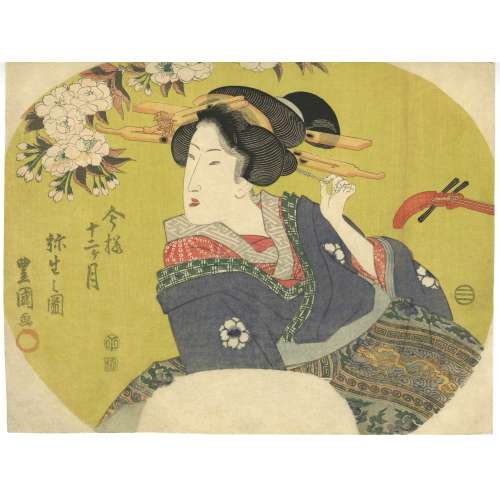 Title: Third lunar month [弥生] (Yayoi no zu); Series: Fashionable Twelve Months (Imayo juni-kagetsu). Another version of translation: Modern Beauties of Twelve Months. Artist: Utagawa Toyokuni I [歌川豊国] (1769–1825). Pubisher: Ibaya Senzaburō [伊場屋仙三郎] (Japanese, 1815 – 1869), seal: Dansendō [伊場仙]. Signed: Toyokuni ga and sealed with toshidama. Date-kiwame seal: Ushi (ox), Bunsei 5 (1822). Size: double-sheet uncut fan print ( aiban uchiwa-e), 219 x 295 mm.
Title: Third lunar month [弥生] (Yayoi no zu); Series: Fashionable Twelve Months (Imayo juni-kagetsu). Another version of translation: Modern Beauties of Twelve Months. Artist: Utagawa Toyokuni I [歌川豊国] (1769–1825). Pubisher: Ibaya Senzaburō [伊場屋仙三郎] (Japanese, 1815 – 1869), seal: Dansendō [伊場仙]. Signed: Toyokuni ga and sealed with toshidama. Date-kiwame seal: Ushi (ox), Bunsei 5 (1822). Size: double-sheet uncut fan print ( aiban uchiwa-e), 219 x 295 mm.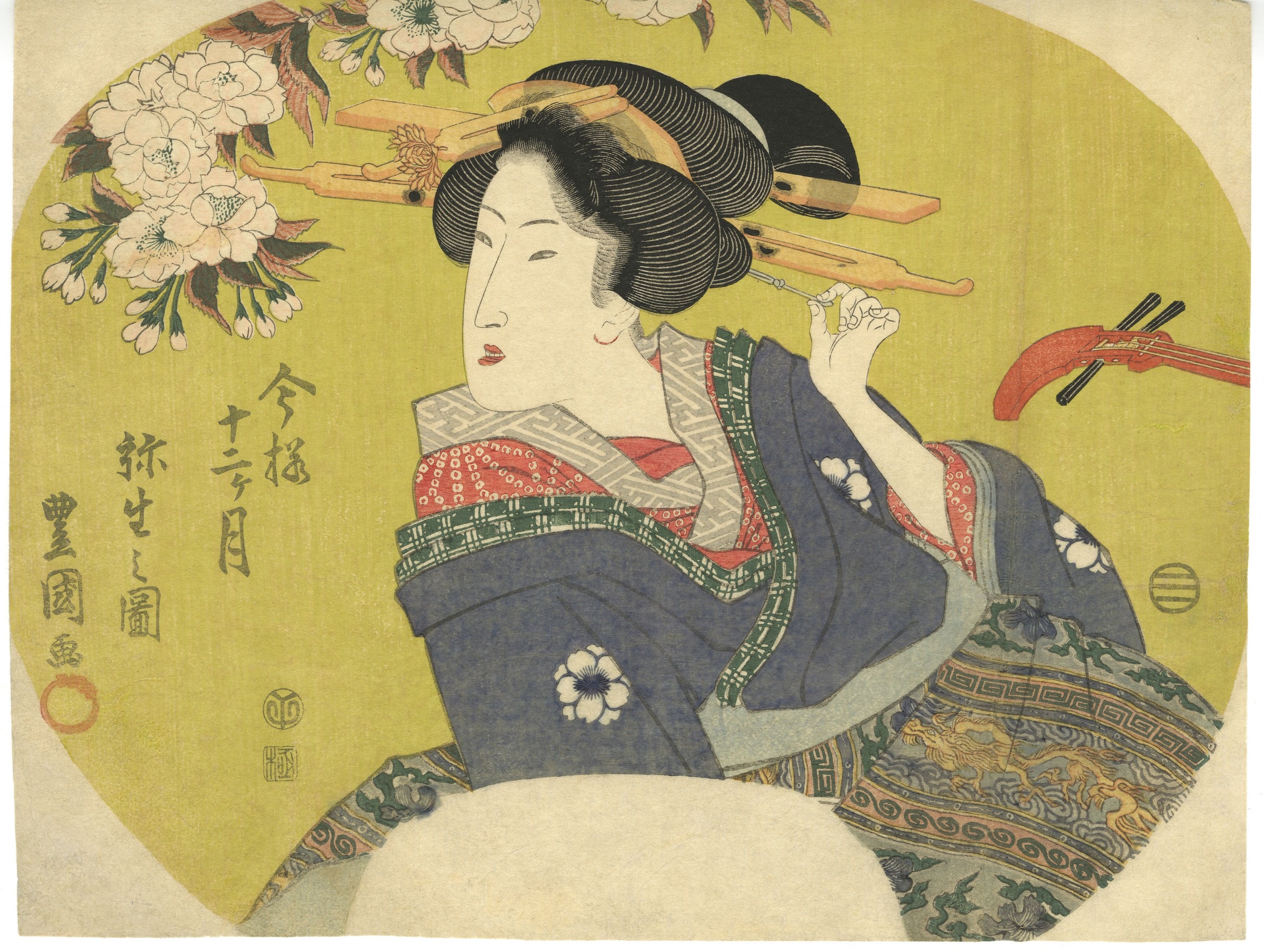
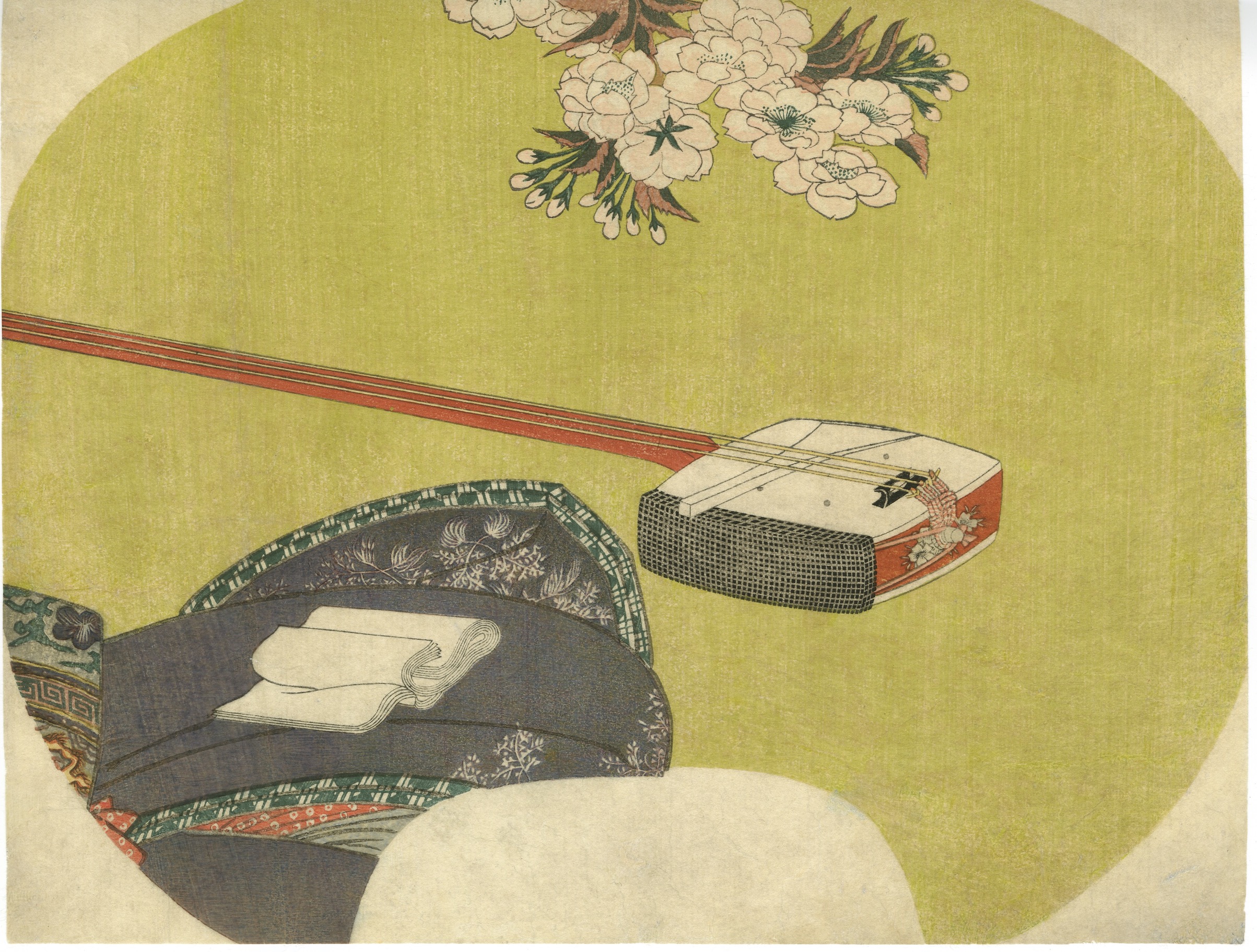
-
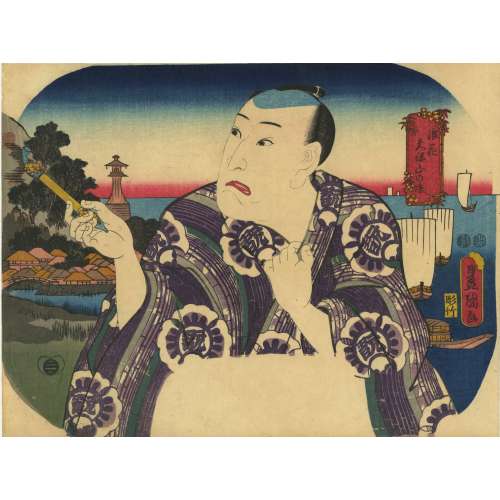 Artist: Utagawa Kunisada [歌川 国貞] a.k.a. Utagawa Toyokuni III [三代歌川豊国] (Japanese, 1786 – 1865). Signed: Toyokuni ga [豊国 画] in a red toshidama cartouche. Publisher: Ibaya Senzaburō [伊場屋仙三郎] (Japanese, c. 1815 – 1869). Block carver: Yokokawa Takejirō [横川竹二郎] (Japanese, fl. 1845 – 1863); seal Hori Take [彫竹]. Double nanushi censor seals: Mera & Murata (1847-50). Title: Cool Breeze on Tenpōzan Hill in Naniwa [浪花天保山の涼] (Naniwa Tenpōzan no ryō). An uncut fan print (uchiwa-e), depicting a gentleman (most probably kabuki actor Nakamura Utaemon IV) holding a pipe with the view of Tenpōzan Hill [天保山] in Naniwa (Osaka) in the background. A distinctive structure on the left is the Sumiyoshi Lantern [住吉高灯篭] (Sumiyoshi takadōrō), which was destroyed by a typhoon in 1950. The character 翫 – moteasobu – on the gentleman’s robe means "take pleasure, play an instrument". Nakamura Utaemon IV [中村歌右衛門] (Japanese, 1796 – 1852); other names: Nakamura Shikan II, Nakamura Tsurusuke I, Nakamura Tōtarō. The character is visually similar to a gentleman drinking tea on a veranda under the shining moon from the series ‘Moon, Sun, Stars’ [月日星] (Getsu hi hoshi), see SVJP-0211-1.2016: The Moon.
Artist: Utagawa Kunisada [歌川 国貞] a.k.a. Utagawa Toyokuni III [三代歌川豊国] (Japanese, 1786 – 1865). Signed: Toyokuni ga [豊国 画] in a red toshidama cartouche. Publisher: Ibaya Senzaburō [伊場屋仙三郎] (Japanese, c. 1815 – 1869). Block carver: Yokokawa Takejirō [横川竹二郎] (Japanese, fl. 1845 – 1863); seal Hori Take [彫竹]. Double nanushi censor seals: Mera & Murata (1847-50). Title: Cool Breeze on Tenpōzan Hill in Naniwa [浪花天保山の涼] (Naniwa Tenpōzan no ryō). An uncut fan print (uchiwa-e), depicting a gentleman (most probably kabuki actor Nakamura Utaemon IV) holding a pipe with the view of Tenpōzan Hill [天保山] in Naniwa (Osaka) in the background. A distinctive structure on the left is the Sumiyoshi Lantern [住吉高灯篭] (Sumiyoshi takadōrō), which was destroyed by a typhoon in 1950. The character 翫 – moteasobu – on the gentleman’s robe means "take pleasure, play an instrument". Nakamura Utaemon IV [中村歌右衛門] (Japanese, 1796 – 1852); other names: Nakamura Shikan II, Nakamura Tsurusuke I, Nakamura Tōtarō. The character is visually similar to a gentleman drinking tea on a veranda under the shining moon from the series ‘Moon, Sun, Stars’ [月日星] (Getsu hi hoshi), see SVJP-0211-1.2016: The Moon. As noted by Horst Graebner, the gentleman also resembles the character on another Kunisada's actor print, published in 1852 (Waseda University Cultural Resources Database № 114-0232):
As noted by Horst Graebner, the gentleman also resembles the character on another Kunisada's actor print, published in 1852 (Waseda University Cultural Resources Database № 114-0232):
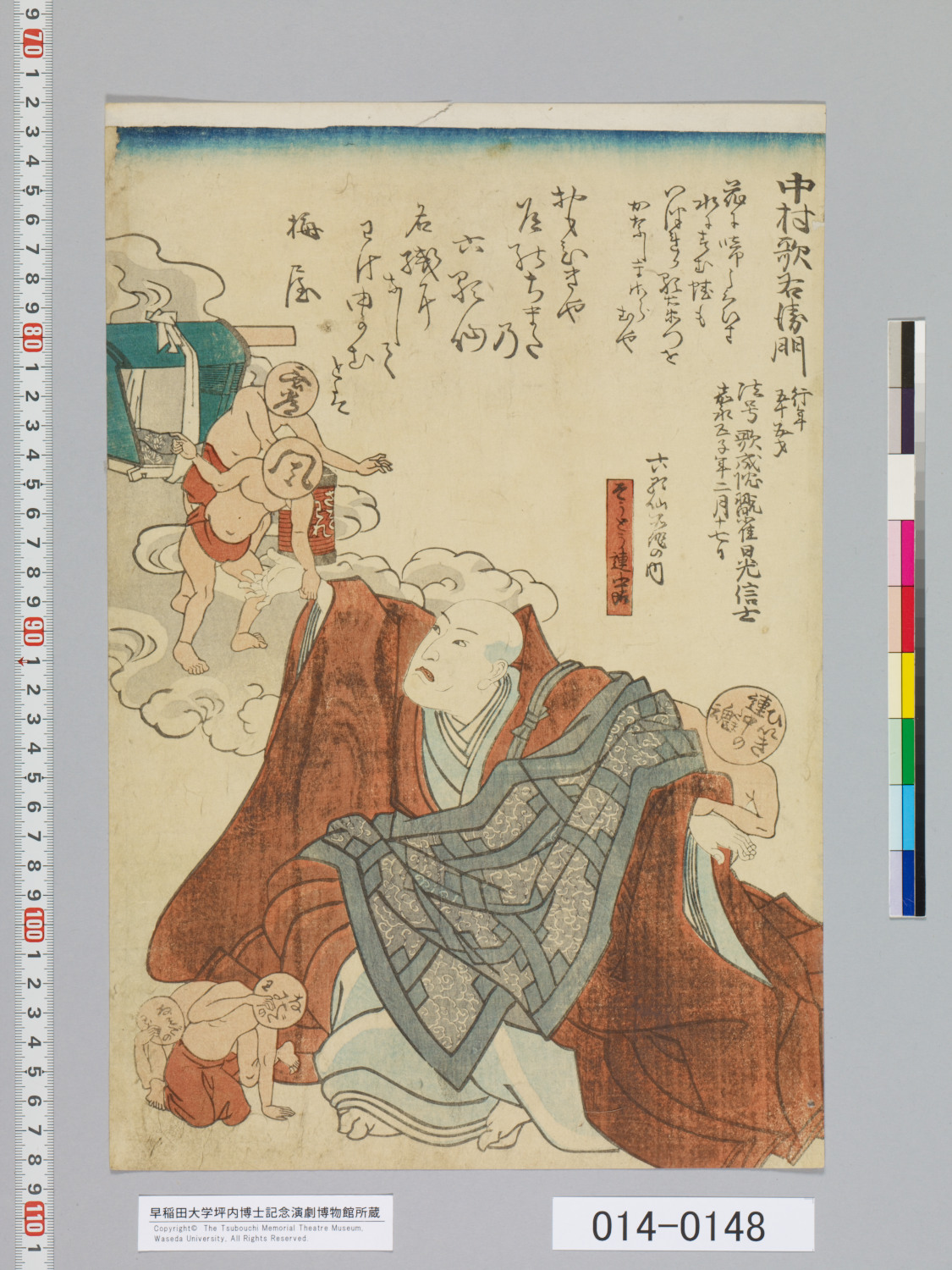
-
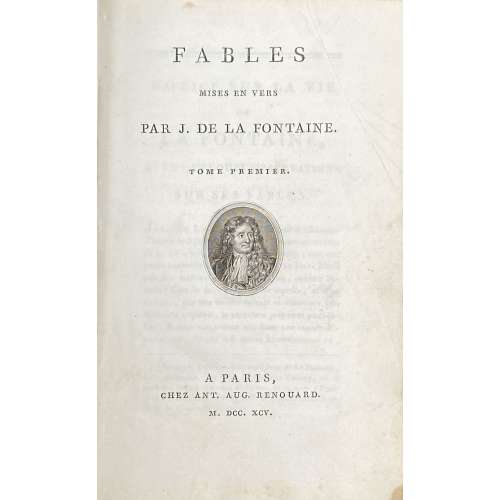 Two 8vo volumes bound in one, 19 x 12.5 cm, in full mottled sheepskin with gilt-bordered boards, gilt decorated flat spine with gilt-lettered red and black calf labels, rebacked, marbled endpapers and edges, printed on wove paper, plates on thicker laid paper. Title-page: FABLES | MISES EN VERS | PAR J. DE LA FONTAINE. | TOME PREMIER (SECOND). | {medallion portrait} (printer’s device “PC”) | A PARIS, | CHEZ ANT. AUG. RENOUARD. | M. DCC. XCV. || Collation: Vol. 1: π2 (h.t./imprint, t.p. medallion portrait/blank), [1]-38 (Notice sur la vie…), 1-58 64 (Vie de la Fontaine, Épitre, Préface, Vie d’Ésope), [7]-148 156 χ3 (table); pagination [4] [i] ii-xlviii, [1] 2-234. Total 143 leaves (286 pages) plus 6 plates after Moreau le Jeune by Devilliers fratres (p. 112), E. De Ghendt (pp. 122 and 181), Jean Louis Delignon (p. 140), Delvaux (p. 197), and Ph. Trière (p. 219). Title medallion portrait of La Fontaine (G Rigault pinx. – C S Gaucher inc.) by Gaucher after Rigaud. Vol. 2: π2 1-158 164; pagination [4] [1] 2-247 [248 blank]. Total 126 leaves (252 pages) plus 6 plates after Moreau le Jeune by Devilliers fratres (p. 19), Villerey (pp. 37, 80, and 146), Bosq (p. 121), and Ph. Trière (p. 199). The book published in 1795 (An 3) supplemented with plates produced in 1811 and 1812 for Œuvres complèttes (sic) de Jean de la Fontaine published by Lefèvre in 1814. The reason for choosing this particular edition for someone's library shortly after 1814 was probably the absence of censorship in 1795. Catalogue raisonné: (1) Lewine [LIB-2538.2020] on p. 276 (Paris, chez Renouard, 1795, 2 vols., 8vo., medal portrait on first title, and 12 plates after Moreau by Delvaux, Bosq, Ghendt, Trière, and Villerey). (2) M.-J.-F. Mahérault. L' oeuvre de Moreau le Jeune : catalogue raisonné et descriptif avec notes iconographiques et bibliographiques. — Paris: A. Labitte, 1880. Contributors: Jean de La Fontaine (French, 1621–1695) – author. Jean-Michel Moreau le Jeune (French, 1741–1814) – artist. Hyacinthe Rigaud (French, 1659 – 1743) – artist. Antoine-Augustin Renouard (French, 1765 – 1853) – publisher. Pierre Causse (French, 1761 – 1834) – printer. Engravers: Charles Étienne Gaucher (French, 1741 – 1804) Etienne De Villiers [Devilliers, Devilliers fratres] (French, 1784 – after 1844) Emmanuel Jean Nepomucène de Ghendt (Flemish, worked in France, 1738 – 1815) Jean-Louis Delignon (French, 1755 – 1820) Rémi Henri Joseph Delvaux (French, 1748 – 1823) Philippe Trière (French, 1756 – c. 1815) Auguste Villerey (French, 1801 – 1846) Jean Bosq (French, fl. c. 1801 – 1844)
Two 8vo volumes bound in one, 19 x 12.5 cm, in full mottled sheepskin with gilt-bordered boards, gilt decorated flat spine with gilt-lettered red and black calf labels, rebacked, marbled endpapers and edges, printed on wove paper, plates on thicker laid paper. Title-page: FABLES | MISES EN VERS | PAR J. DE LA FONTAINE. | TOME PREMIER (SECOND). | {medallion portrait} (printer’s device “PC”) | A PARIS, | CHEZ ANT. AUG. RENOUARD. | M. DCC. XCV. || Collation: Vol. 1: π2 (h.t./imprint, t.p. medallion portrait/blank), [1]-38 (Notice sur la vie…), 1-58 64 (Vie de la Fontaine, Épitre, Préface, Vie d’Ésope), [7]-148 156 χ3 (table); pagination [4] [i] ii-xlviii, [1] 2-234. Total 143 leaves (286 pages) plus 6 plates after Moreau le Jeune by Devilliers fratres (p. 112), E. De Ghendt (pp. 122 and 181), Jean Louis Delignon (p. 140), Delvaux (p. 197), and Ph. Trière (p. 219). Title medallion portrait of La Fontaine (G Rigault pinx. – C S Gaucher inc.) by Gaucher after Rigaud. Vol. 2: π2 1-158 164; pagination [4] [1] 2-247 [248 blank]. Total 126 leaves (252 pages) plus 6 plates after Moreau le Jeune by Devilliers fratres (p. 19), Villerey (pp. 37, 80, and 146), Bosq (p. 121), and Ph. Trière (p. 199). The book published in 1795 (An 3) supplemented with plates produced in 1811 and 1812 for Œuvres complèttes (sic) de Jean de la Fontaine published by Lefèvre in 1814. The reason for choosing this particular edition for someone's library shortly after 1814 was probably the absence of censorship in 1795. Catalogue raisonné: (1) Lewine [LIB-2538.2020] on p. 276 (Paris, chez Renouard, 1795, 2 vols., 8vo., medal portrait on first title, and 12 plates after Moreau by Delvaux, Bosq, Ghendt, Trière, and Villerey). (2) M.-J.-F. Mahérault. L' oeuvre de Moreau le Jeune : catalogue raisonné et descriptif avec notes iconographiques et bibliographiques. — Paris: A. Labitte, 1880. Contributors: Jean de La Fontaine (French, 1621–1695) – author. Jean-Michel Moreau le Jeune (French, 1741–1814) – artist. Hyacinthe Rigaud (French, 1659 – 1743) – artist. Antoine-Augustin Renouard (French, 1765 – 1853) – publisher. Pierre Causse (French, 1761 – 1834) – printer. Engravers: Charles Étienne Gaucher (French, 1741 – 1804) Etienne De Villiers [Devilliers, Devilliers fratres] (French, 1784 – after 1844) Emmanuel Jean Nepomucène de Ghendt (Flemish, worked in France, 1738 – 1815) Jean-Louis Delignon (French, 1755 – 1820) Rémi Henri Joseph Delvaux (French, 1748 – 1823) Philippe Trière (French, 1756 – c. 1815) Auguste Villerey (French, 1801 – 1846) Jean Bosq (French, fl. c. 1801 – 1844) -
![[Hippolyte Prosper Olivier LISSAGARAY]. History of the Commune of 1871 / Translated from the French of Lissagaray by Eleanor Marx Aveling. London: Reeved and Turner, 1886. pp.: [i-v] vi-xv [1] 2-500.](https://varshavskycollection.com/wp-content/uploads/2021/02/LIB-1110.2016-d-500x500.jpeg) Hardcover volume, collated in-8o, 21.9 c 14.6 cm, bound in half red morocco over red buckram by Palmer, Hove & Co. (Manchester), ruled in gilt, marbled end-papers, top edge gilt, spine with raised bands, ruled in gilt, gilt lettering; bookplate "Ex libris William John Robertson" with black ink ms dated 1922 to front pastedown. Insert paper clipping “In Memoriam” marked “D.W. 25.1.61.” Graphite ms to t.p.: “[assisted by Karl Marx]”. Pp.: [i-v] vi-xv [xvi blank], [1] 2-500; collation: ffl blank first and last, π8 A-2H8 2I2. Title-page: HISTORY | OF | THE COMMUNE OF 1871. | Translated from the French of | LISSAGARAY, | BY | ELEANOR MARX AVELING. | LONDON: | REEVES AND TURNER, 196 STRAND. | 1886.|| Contributors: Hippolyte Prosper-Olivier Lissagaray (French, 1838 – 1901) – author. Eleanor Marx [Aveling] (British, 1855 – 1898) – translator. William John Robertson (Canadian, 1846 – 1894) – provenance. The Russian translation of the same title: [LIB-1158.2016] Э. Лиссагарэ. История Парижской Коммуны в 1871 г. (Дешевая библиотека, № 274) / Пер. под ред. В. Базарова. — С.-Петербург: Знание, 1906.
Hardcover volume, collated in-8o, 21.9 c 14.6 cm, bound in half red morocco over red buckram by Palmer, Hove & Co. (Manchester), ruled in gilt, marbled end-papers, top edge gilt, spine with raised bands, ruled in gilt, gilt lettering; bookplate "Ex libris William John Robertson" with black ink ms dated 1922 to front pastedown. Insert paper clipping “In Memoriam” marked “D.W. 25.1.61.” Graphite ms to t.p.: “[assisted by Karl Marx]”. Pp.: [i-v] vi-xv [xvi blank], [1] 2-500; collation: ffl blank first and last, π8 A-2H8 2I2. Title-page: HISTORY | OF | THE COMMUNE OF 1871. | Translated from the French of | LISSAGARAY, | BY | ELEANOR MARX AVELING. | LONDON: | REEVES AND TURNER, 196 STRAND. | 1886.|| Contributors: Hippolyte Prosper-Olivier Lissagaray (French, 1838 – 1901) – author. Eleanor Marx [Aveling] (British, 1855 – 1898) – translator. William John Robertson (Canadian, 1846 – 1894) – provenance. The Russian translation of the same title: [LIB-1158.2016] Э. Лиссагарэ. История Парижской Коммуны в 1871 г. (Дешевая библиотека, № 274) / Пер. под ред. В. Базарова. — С.-Петербург: Знание, 1906. -
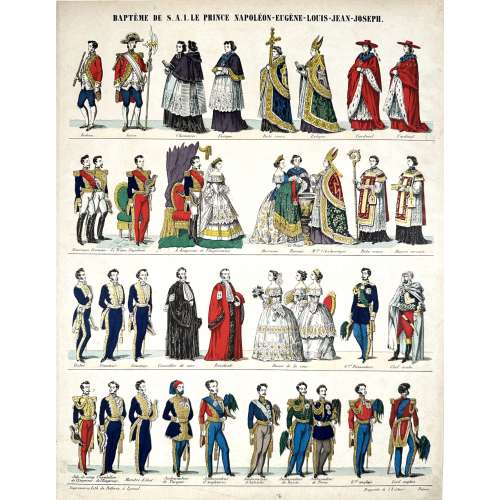 Hand-coloured woodcut on wove paper, 460 x 363 mm; black ink stamp “5054” to reverse. Four tiers with groups of people dressed in uniform, captioned: Bedeau — Suisse — Chanoines — Évêque — Porte croix — Évêque — Cardinal — Cardinal | Généraux français — Le prince Napoléon — L’Empereur et l’Impératrice — Marraine — Le Prince — Parrain | Meur l’Archevêque | Porte crosse Diacre servant | Préfet — Sénateur — Conseiller de cour — Président — Dames de la cour — Gral Piémontais — Chef arabe | Aide-de-camp de l’Empereur — Chambellan de l’Empereur — Ministre d’état — Ambassadeur de Turque | Ambassadeur d’Angleterre — Ambassadeur d’Autriche — Ambassadeur de Russie — Ambassadeur de Prusse — Gral anglaise — Lord anglais || Bottom left: Imprimerie Lith. de Pellerin, à Épinal; right: Propriété de l’Éditeur. — Déposé. Jean Charles Pellerin (French, 1756 – 1836) – printer/publisher.
Hand-coloured woodcut on wove paper, 460 x 363 mm; black ink stamp “5054” to reverse. Four tiers with groups of people dressed in uniform, captioned: Bedeau — Suisse — Chanoines — Évêque — Porte croix — Évêque — Cardinal — Cardinal | Généraux français — Le prince Napoléon — L’Empereur et l’Impératrice — Marraine — Le Prince — Parrain | Meur l’Archevêque | Porte crosse Diacre servant | Préfet — Sénateur — Conseiller de cour — Président — Dames de la cour — Gral Piémontais — Chef arabe | Aide-de-camp de l’Empereur — Chambellan de l’Empereur — Ministre d’état — Ambassadeur de Turque | Ambassadeur d’Angleterre — Ambassadeur d’Autriche — Ambassadeur de Russie — Ambassadeur de Prusse — Gral anglaise — Lord anglais || Bottom left: Imprimerie Lith. de Pellerin, à Épinal; right: Propriété de l’Éditeur. — Déposé. Jean Charles Pellerin (French, 1756 – 1836) – printer/publisher. -
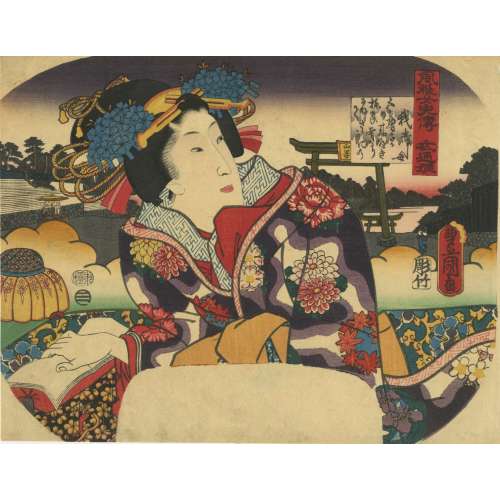 Artist: Utagawa Kunisada [歌川 国貞], a.k.a. Utagawa Toyokuni III [三代 歌川 豊国] (Japanese, 1786 – 1865). Signed: Toyokuni ga [豊国 画] in a red toshidama cartouche Block carver: Yokokawa Takejirō [横川竹二郎] (Japanese, fl. 1845 – 1863), seal: 彫竹 – hori Take. Publisher: Ibaya Senzaburō [伊場屋仙三郎] (Japanese, fl. c. 1845 – 1847). Media: Untrimmed fan print (uchiwa-e), 230 x 295 mm. Combined date seal and kiwame censor seal: Ansei 6 (1859). Title: Princess Sotoori [衣通姫] (Sotoori-hime) – Sotoori-hime was a concubine of Emperor Ingyo (reigned AD 412-53), and one of the Three Gods of Japanese Poetry [和歌三神] (Waka sanjin). Series: Chronicles of Elegant Women [風雅女史傳] (Fūga joshiden). The sign on the torii (Shinto shrine gates) reads: Mountain king shrine [山王宮] – it is the Sannō Shrine at the Nagata Riding Grounds in Edo. A print with these gates is at MFA (Boston) # 21.9853.
Artist: Utagawa Kunisada [歌川 国貞], a.k.a. Utagawa Toyokuni III [三代 歌川 豊国] (Japanese, 1786 – 1865). Signed: Toyokuni ga [豊国 画] in a red toshidama cartouche Block carver: Yokokawa Takejirō [横川竹二郎] (Japanese, fl. 1845 – 1863), seal: 彫竹 – hori Take. Publisher: Ibaya Senzaburō [伊場屋仙三郎] (Japanese, fl. c. 1845 – 1847). Media: Untrimmed fan print (uchiwa-e), 230 x 295 mm. Combined date seal and kiwame censor seal: Ansei 6 (1859). Title: Princess Sotoori [衣通姫] (Sotoori-hime) – Sotoori-hime was a concubine of Emperor Ingyo (reigned AD 412-53), and one of the Three Gods of Japanese Poetry [和歌三神] (Waka sanjin). Series: Chronicles of Elegant Women [風雅女史傳] (Fūga joshiden). The sign on the torii (Shinto shrine gates) reads: Mountain king shrine [山王宮] – it is the Sannō Shrine at the Nagata Riding Grounds in Edo. A print with these gates is at MFA (Boston) # 21.9853.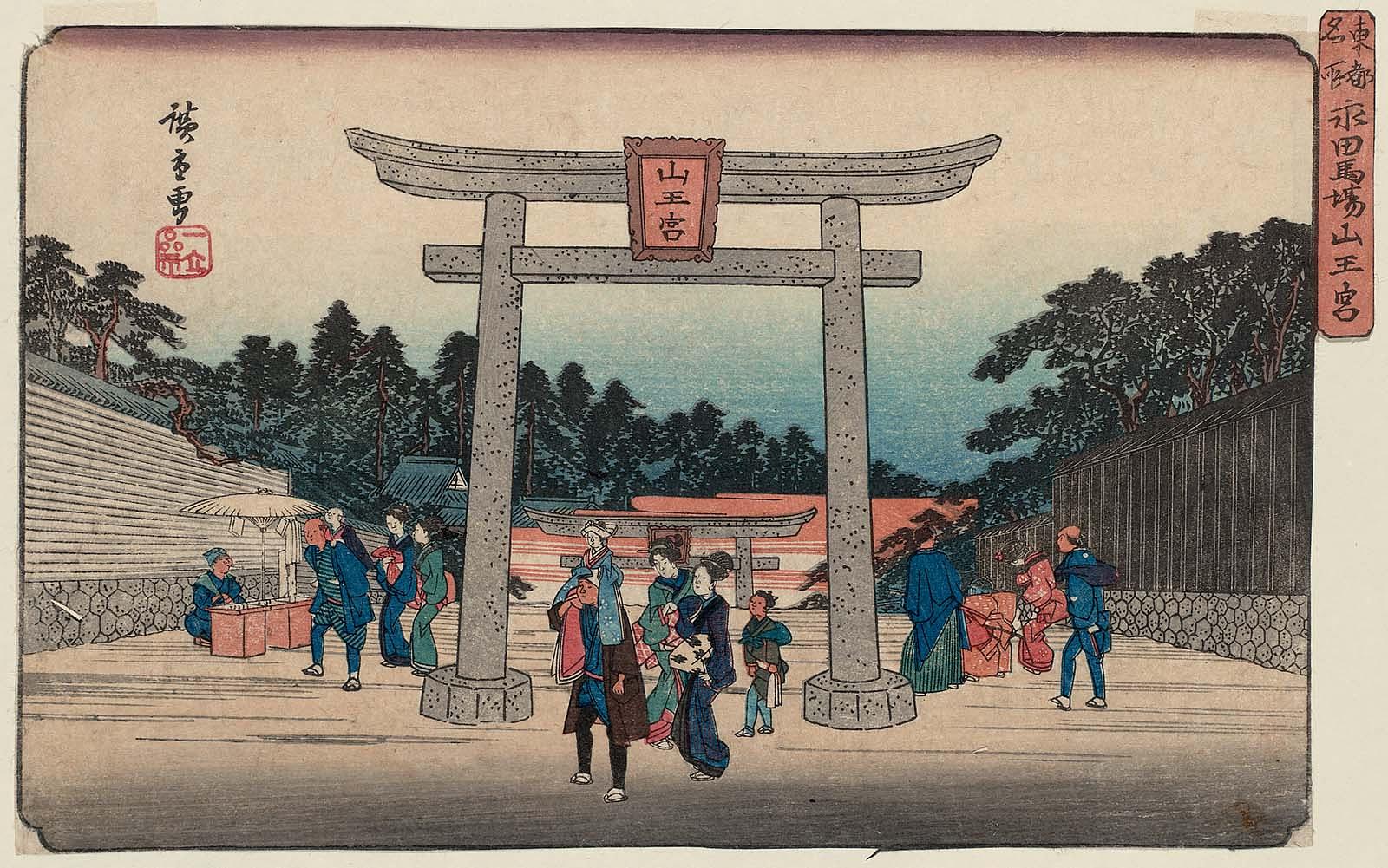 Other prints from the same series in this collection:
SVJP-0343.2021 — Tamagiku:
Other prints from the same series in this collection:
SVJP-0343.2021 — Tamagiku:
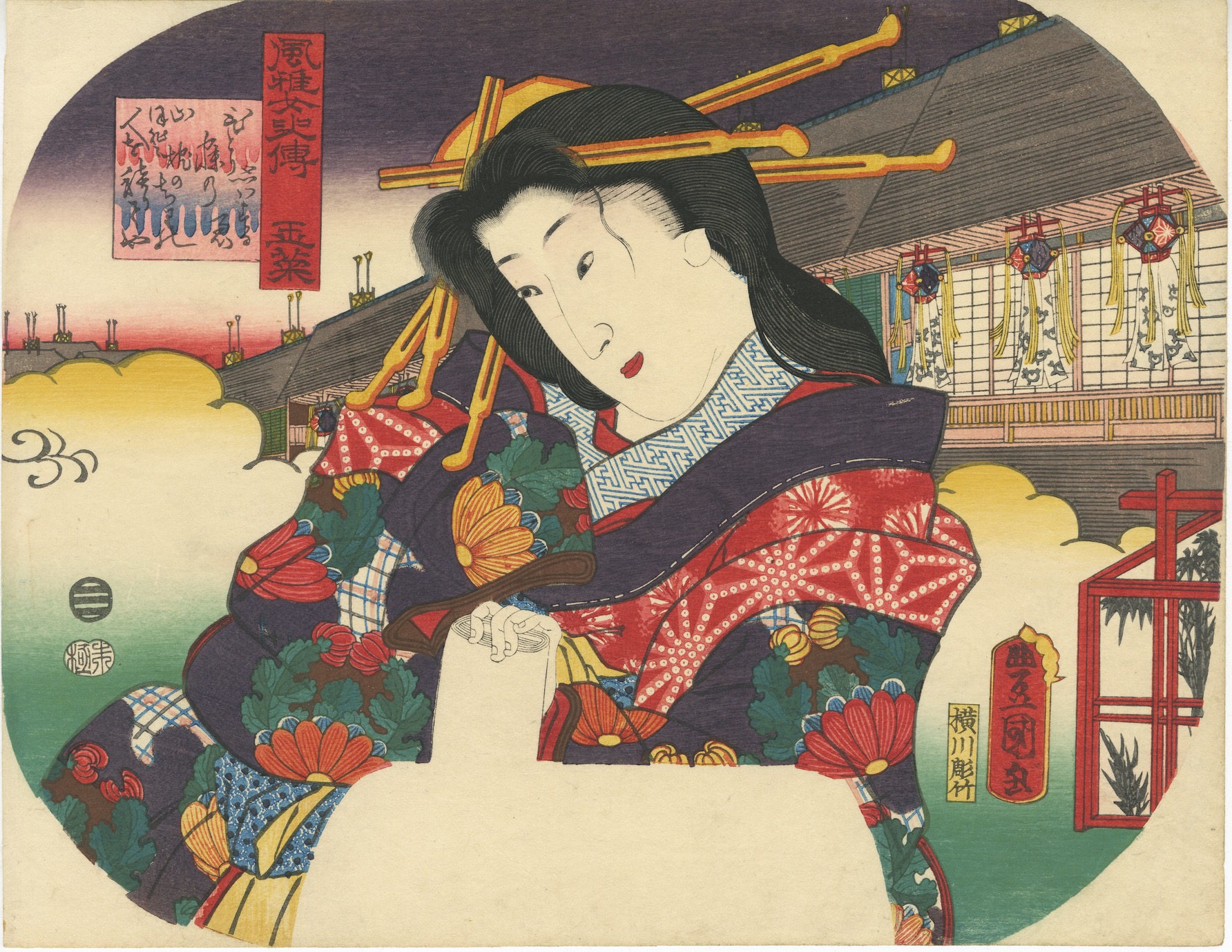 SVJP-0400.2023 — Saiko:
SVJP-0400.2023 — Saiko:
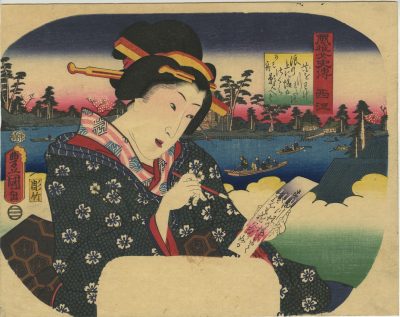 Note: Special thanks to Horst Graebner, who helped decipher and understand the meaning.
Note: Special thanks to Horst Graebner, who helped decipher and understand the meaning.


